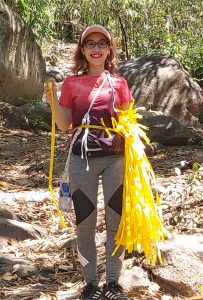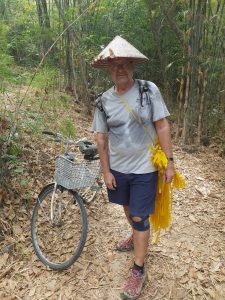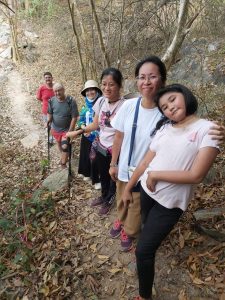To be a hare
ARE YOU GOING TO BE A "HASH HARE"
HASHING ON THE MOUNTAINS OF VUNG TAU - BA RIA PROVINCE
HASHING ON THE MOUNTAINS OF VUNG TAU - BA RIA PROVINCE
Role & and responsibilities
A successful Hare is a special kind of person. He or she must have an adventurous spirit and the determination to make it happen, despite the many challenges along the way. Above all, they must be “diplomats”!
Why? Because laying trails in someone else’s country presents 
 unique challenges: even if you speak the language well enough
unique challenges: even if you speak the language well enough
to “get by”, you’re still embarking on a steep learning curve about the culture – which can be quite different between the city and countryside, despite their close proximity to each other in Ba Ria Vung Tau province.
The best tip is to keep smiling and keep moving! A smile and a wave will get you everywhere! (as long as you haven’t just trampled all over and/or left paint marks on the family’s vegie patch, of course!).
Finding and setting trails, and shepherding Hashers, is great fun but not always easy. And that’s why we’ve compiled the following tips that just might save you making some of the more common mistakes – On On!
Keep to the schedule
Most important of all – if something unavoidable happens to stop you setting a trail after you’ve “volunteered” to do so, you must tell the Hare Raiser or another member of Mismanagement as soon as possible so you can be replaced (or a different known trail substituted).
Safety first

 A minimum of two Hares is mandatory in most Hash chapters and certainly in VTCH3 – at least one of whom should be experienced. It’s not unknown for Hares to be injured or lost when setting or marking trails – and it’s obviously best if you’re not alone in the (however unlikely) event that it happens to you! Swap phone numbers, and take whistles for when there’s no mobile phone or VHF radio coverage. More than two Hares are rarely necessary and will usually serve to do little more than deplete the coffers by having three free runners on Sunday – which is definitely NOT the aim! However, an assistant can be useful to look after the motorbike/s while two Hares are on the trail, and even save time by negotiating a Down Down spot and/or snacks with local small business owners (remembering to get permission from Mismanagement if discussing costs/payments above the authorised amount – usually a maximum of 400k VND).
A minimum of two Hares is mandatory in most Hash chapters and certainly in VTCH3 – at least one of whom should be experienced. It’s not unknown for Hares to be injured or lost when setting or marking trails – and it’s obviously best if you’re not alone in the (however unlikely) event that it happens to you! Swap phone numbers, and take whistles for when there’s no mobile phone or VHF radio coverage. More than two Hares are rarely necessary and will usually serve to do little more than deplete the coffers by having three free runners on Sunday – which is definitely NOT the aim! However, an assistant can be useful to look after the motorbike/s while two Hares are on the trail, and even save time by negotiating a Down Down spot and/or snacks with local small business owners (remembering to get permission from Mismanagement if discussing costs/payments above the authorised amount – usually a maximum of 400k VND).
Take precautions
Take all the usual precautions, ie hat, sunscreen, insect repellent, sturdy shoes, long sleeves/socks/trousers, etc – and maybe a book for your assistant to read. A good trail or trails takes hard work and often a long day (or two) in the sun or rain: firstly to establish the trail, then to mark it – you’re rarely lucky enough to be able to mark the trail as you find it (without constantly having to back-track to change direction and markers). Long trousers and/or socks can be useful to help avoid insect bites when standing still to mark the trail – especially if tying coloured ribbon around trees and shrubbery, which often gives plenty of time for “nasties” to home-in on your ankles and lower legs!
Be friendly
Greet people, especially outside the city, with “Xin Chao” or “Hello” (or both) and a smile – and always try to get permission from locals before marking their land, especially in residential areas and pagodas (it’s useful to have a Vietnamese-speaker with you, if possible). Try to explain that “Many people will run here on Sunday” (VN: “Chu Nhat nhieu nguoi chay” which is a truncated translation but usually understood, especially if you simultaneously make a running motion with arms and legs). Confirming that it’s OK with the locals can be as simple as giving the thumbs up while saying “OK?” (with a smile!).
Mark the trail 1.
 The trail should be clearly marked – with markers set a maximum of 50 metres apart on “open” trails but closer in dense undergrowth, etc. Rather than tying markers around random trees or other objects just because you think it’s “time” for another one, a more effective way is to look ahead so, as you tie ribbon on one tree you can already see where the next ribbon should go – and then tie it so the loose ends face the Hashers to give them maximum visibility of the markers. An exception to that rule is when it’s a clear trail, ie a jungle track with no turn-offs – so all the Hashers have to do is follow the track and then look for markers whenever there’s a turn-off (the markers should be set just AFTER the turn-off, not before, to avoid confusion).
The trail should be clearly marked – with markers set a maximum of 50 metres apart on “open” trails but closer in dense undergrowth, etc. Rather than tying markers around random trees or other objects just because you think it’s “time” for another one, a more effective way is to look ahead so, as you tie ribbon on one tree you can already see where the next ribbon should go – and then tie it so the loose ends face the Hashers to give them maximum visibility of the markers. An exception to that rule is when it’s a clear trail, ie a jungle track with no turn-offs – so all the Hashers have to do is follow the track and then look for markers whenever there’s a turn-off (the markers should be set just AFTER the turn-off, not before, to avoid confusion).
Bio-degradable markers like white shredded paper or flour/chalk are good, but red eco-twine (“ribbon”) is also good, especially in dense undergrowth, and readily available from the markets and hardware shops (blue, green and/or yellow twine are not always effective because they can be difficult to see, especially against foliage). White or red eco-paint should be used ONLY on grass or rocks – remember we’re running on someone else’s land, especially in the city!
Mark the trail 2.
If you use eco-twine, try to cut it about arm’s length or slightly longer (don’t worry – it’s cheap!). It should be tied around trees, fence-posts, overhanging branches, etc preferably around eye-level (which also places it out of reach of playful small children and dogs). Tie a knot first to secure the marker, then tie a large bow to make it stand out against the background – especially when there’s some wind to make the loose ends flutter. It can be time-consuming, but will be appreciated!
Mark the trail 3.
Whatever signs you use for checks, backtracks, false trails, etc – keep them consistent and make sure you include them in your pre-run “chalk talk” (briefing) for the pack.
Manage the trail/s
Always consider two trails – one longer/harder and one shorter/easier, especially when the primary trail might be too difficult for someone/anyone (VTH3 is a family Hash, catering for all ages and average fitness levels). If not possible, consider including “water stops” and even deliberate “Hash Halts” for photo opportunities along the trail (plus false trails and checks, of course) to help keep the pack closed up. A good trail is one where runners and walkers all reach the finish point safely, within 5-10 minutes of each other.
Nominate Walking Hare/s and Running Hare/s), also “Ailing Hash” (aka back-marker, tail-end Charlie, etc), to shepherd any “stray sheep”. It’s more work, but can save a lot of time in the long run by not having to search for anyone after the run. It also shows you have everyone’s best interests at heart, and will surely be appreciated!
Beware King Tides!
If setting all or part of the trail on a beach, make sure you check the charts for that Sunday to avoid the trail being washed out by an unexpected King Tide!
Brief the pack
 Always brief the pack before the run – and give them an opportunity to ask questions, especially when English is not their first language. The brief should include an outline of the trail/s from starting point to finish, including anything in particular to watch out for, such as dogs where children need to be safeguarded, loose bridge planking, etc; also identify the various Hare/s, including who will act as backmarker (“Ailing Hash”) for each trail, and who will be carrying the first aid kit and walkie talkies. And don’t forget to remind everyone to let someone know if they decide to “short cut” straight home on local runs, instead of attending the after-run Circle – otherwise you/we could be searching for them all night!
Always brief the pack before the run – and give them an opportunity to ask questions, especially when English is not their first language. The brief should include an outline of the trail/s from starting point to finish, including anything in particular to watch out for, such as dogs where children need to be safeguarded, loose bridge planking, etc; also identify the various Hare/s, including who will act as backmarker (“Ailing Hash”) for each trail, and who will be carrying the first aid kit and walkie talkies. And don’t forget to remind everyone to let someone know if they decide to “short cut” straight home on local runs, instead of attending the after-run Circle – otherwise you/we could be searching for them all night!
It’s all about YOU!
Hares are responsible not only for selecting and marking the trail, briefing the pack, and making sure everyone gets back safely, around the same time – but also selecting the Circle location, negotiating bus parking, food, etc, and making sure sufficient beer, water, soft drinks and ice are in the eskies before departure; as well as helping the Beermeister empty the eskies on return to the start point, and putting leftovers into storage (after they’ve been counted for the Hash Cash report).
In short, the Hares are responsible for supervising just about everything except collection of run fees on Sundays – for which they receive the gratitude of fellow Hashers, a drink at the Down Down, and a free run! So why do they like doing it so much? Apart from the personal satisfaction from facing all the challenges, it’s a great way to get out and about for at least two days a week, if not more – and discovering more about the local countryside and its people than most tourists or expats (or even locals in many cases) could ever hope to experience!
So good luck, and thanks – your efforts make a significant contribution to everyone’s enjoyment!
